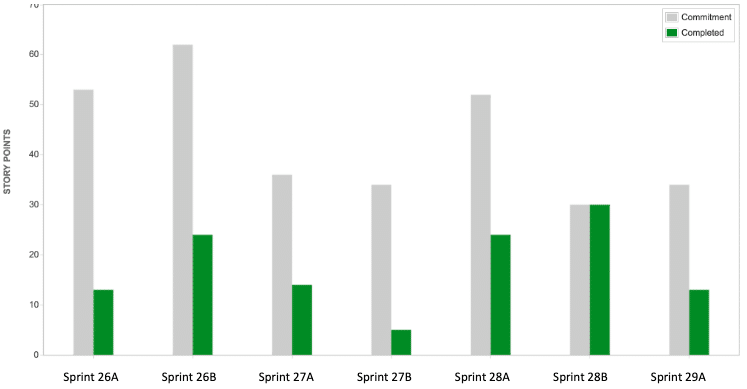5 Tips for Dealing with More Work Than People

Many or all organizations today are struggling with more work than they have people to get the job done. Whether due to competitive pressures or increased customer demands, it seems like all organizations have more work than they have capacity to complete that work. They have too much work!
I suppose we could advise them to do more with less, which has been the prevailing approach for the least 10-15 years. That is actually not very helpful. What does work?
Over the last few years I have seen some things that work and others that don’t work and in some cases, make things worse. Let’s start with the list of things NOT to do first.
Don’t Do This When Dealing With Too Much Work
1. Keep saying Yes to New Requests
One of the reasons that there is more work than capacity is that we are often unwilling to say no to new requests. This happens at the person level, department level and at the organizational level. After all, if our customer “requests” something, then we should do it.
Why do we say yes? For me personally it comes down to being a people pleaser, and a “can do” type of guy. I don’t like to say no to anyone.
That said, I need to balance reality against hope and optimism. I want to manage expectations, without disappointing people.
Many people have similar challenges. It may put your career at risk to push back on delivering something. Your entire planning process may be based on commitments that everyone knows is unrealistic.
The downside of saying yes to new requests at the organizational level is that employees quickly learn that priorities will change. So why bother? May as well work on whatever you want.
2. Keep Starting Things
This item is closely related to the last. People tend to believe that the best chance for getting more work done is to get more work started. But lean principles tell us exactly the opposite – we will get more done if we stop starting new things. All that work in process will hamper productivity.
Introducing new work into a system at capacity means that all work will go slower. Would you rather have 20 initiatives part way done or 5 completed?
We seem to recognize this with driving. The more cars on the road, the more things slow down. And the slowdown is not linear – it quickly gets worse until things grind to a halt. Which is why most Departments of Transportation have introduced ramp metering lights. They limit the introduction of new cars to what the road can handle.

Having lots of things started also brings inefficiencies due to context changes. No matter how good we may think we are at multi-tasking, we actually suck at it. There is a cost of context-switching which experts estimate to be 20% for each switch. Experts believe the cost of multi-tasking to the US economy is a staggering $ 650.
It has been estimated that $ 650 billion a year is wasted in US businesses due to multitasking.
— Wikipedia
All that work in process also carries the burden of tracking, status reporting and problem escalation. The more things you have going on the more likely some are going to run behind schedule and that requires management to look into them. Do you see the downward spiral?
3. Encourage Unofficial Channels and Hidden Work
What inevitably happens when there is too much work is that creative people find workarounds to get their particular pet projects done or needs met. We all know the people in our organizations who we can call to get a favor done or to jump the official queue of work. Or we have the clout to pull someone off a team or another piece of work to get them to work on our initiative. We would not be good leaders if we weren’t able to get things done even when official channels are over capacity.
Company culture may also play a role. I know more than one organization that has a long tradition of dropping what you are working on if you get a request from an internal customer or co-worker. This “shoulder-tapping” was popular for the requestors but killed both productivity and predictability.
What you will find is that the more the organization is overcapacity, the more the unofficial channels will be used, until eventually the unofficial channels is where all the work goes. And it is hidden.
4. Introduce a new Tool
Some organizations believe the solution to too much work is to introduce a new tool. The ones I hear the most about are ServiceNow and Jira.
While the introduction of those tools may help to bring transparency, they alone don’t add any value to the process. Perhaps having everyone enter their request in one place and having triage rules will make it look like more work is getting done. More work may be visible, but more is not getting done.
Adding a tool is a form of suboptimization. Rather than look at the overall value stream and how work gets done, the tool will optimize one part of the process without changing the overall outcome.
I am amazed sometimes at the magical powers some people believe tools have. Most of these tools actually encourage more work in process. At best they speed up work that should never be done in the first place.
5. Push Work on People and Set Aggressive Target Dates
Some leaders think the best way to maximize productivity is to push the work on people and set aggressive target dates. They believe that you have to push people to get they best out of them and that aggressive deadline dates work better than what the team would set for themselves.
A key client of mine a few years ago was struggling. They were using Scrum but their teams had unpredictable delivery. Here are a few charts showing planned vs. actual velocity from this period showing that the team consistently missed the mark. But why?

As it turns out, this is the consequence that comes from setting unrealistic deadlines. Somewhere prior to sprint 26A, the team had been challenged to launch the new version of the application into production. The date set by leadership was aggressive and more importantly, unrealistic.
Faced with an unsolvable problem (delivering more than was possible with the time and people available), the team members used the only lever they had to available to them – quality. This should come as no surprise to anyone. When teams are not given flexibility to control anything else, they will cut corners on quality to make the date.
That decision to go live the previous year brought with it technical debt. The interest on the debt was compounding every sprint and after about 7 months later, every sprint was interrupted by production support problems. It was entirely predictable that each sprint would have a problem and the Dev Manager would pull all the developers into emergency meetings to fix those problems, abandoning the sprint. That is NOT the type of predictability that is helpful.
What was most sad about the situation was that the team ignored their sprint after sprint experience and kept setting unachievable sprint goals (see “commitment” in the chart above). They had become conditioned to not submit aggressive plans for the next delivery, even though that was exactly the behavior that caused the current condition. Insanity anyone?
5 Tips for Dealing with More Work than People
1. First, Recognize this is the New Normal
Unfortunately, this is not a temporary condition. There is always going to be too much work. If for some reason you are imbalanced and have more people than you have work, you are probably already on your way out of business. For you, the problem to fix is your sales engine or update your resume.
The reason it is important to recognize that this is the new normal is to be realistic. This problem of too much work is not going away and we can’t expect to roll up our sleeves and work our way out of it. It is not a matter of a short term push, or to simply work a little harder. Most short term pushes have negative side effects as mentioned above. Rather than simply dig in and work a little harder, we need to be strategic, take the long term view and work smarter.
2. Be Selective and Focused
I am sure that this will be a surprise to no one but we need to be selective about what is worked on. You need to pick the work that is more important and make that the priority. Establish those organization-wide priorities and use that to align people to the work. Everything in your organization cannot be high-priority. Decisions, sometimes tough decisions, need to be made about what it is that will be most important.
Correspondingly, we need to restrict or eliminate the non-important work. This is the part that most organizations struggle with. Even if they have top priorities, they continue with lower priority work that should be deferred or killed outright.
Sometimes the argument for working on the low priority work is that it keeps people busy. That would be like introducing more cars on a busy expressway every time there is an opening between two cars. This misplaced desire to get people fully utilized reduces slack and decreases productivity, rather than increasing it.
Killing off the hidden and low priority work will help keep people focused on the the most important work. As that work gets done (faster), it will create momentum and excitement that doesn’t exist when many things are moving at glacier speeds.
Agile and Lean Portfolio techniques will prove helpful here. I recommend Sally Elatta’s videos on this topic, start her video Re-Thinking Portfolio Management. Other techniques such as looking at cost of delay and weighted shortest job first are also applicable here.
3. Work Effectively on The High Priority Work
Having narrowed the focus to the most important work of the organization, the next logical step is to work on that high priority work in the most effective way.
This may require stepping back and looking at how work gets done across the organization. Functional silos are among the usual suspects for inefficiencies.
Your organization structure may actually be causing inefficiencies due to internal handoffs, bottlenecks and lack of end to end ownership. Depending on the nature of the high priority work, it may make sense to temporarily or permanently change the organization to eliminate structural barriers such as handoffs and bottlenecks. Value Stream Mapping is a useful technique to bring clarity to how work gets done in your organization.
The Scrum Framework would be a recommended approach to getting work done by teams. To get the maximum bang for your buck from those teams, strive for high-performance:
- Teams should be cross-functional teams with the ability to deliver full functionality without handoffs
- Teams should be appropriately sized – 5 or 6 tend to perform better than 7 or 8 and I would not exceed 8 in any case
- Leverage long-standing teams rather than moving people around
- Dedicate team members so that they can focus on just one team, rather than diluting their efforts across multiple teams
- Co-locate Teams – if your focus is to be competitive and get the high priority work done, then you want people working face to face. Sure people love to work from home but studies have shown that co-locating teams doubled the productivity. You do the math.
- Finally, do Scrum well. Train teams members and get competent and skillful Scrum Members and Product Owners. Provide coaching as needed.
4. Use Pull Systems, not Push Systems
We saw above the cost of pushing too much work on people. More effective is to use pull strategies that allow teams to pull work as they have capacity. If using Kanban approaches at the portfolio level as suggested in item 2 above, teams will have a clear line of sight to the enterprise backlog and pull work as they have capacity.
This requires trust and realism. We need to trust that the teams are working to capacity. Theory X and Y is beyond the scope of this article but if you believe that people are basically lazy and unmotivated (except ourselves of course), trust is going to be difficult.
Realism is also required. Hope is the worst planning tool ever but that doesn’t make it unpopular. Don’t use hope. Use reality based forecasting techniques that leverage actual data from the past to forecast the future.
Don’t force delivery dates or pluck them from the air. Instead, work with the teams to provide realistic dates based on team velocity or run rates. Chunk out big initiatives into smaller bites that can be accomplished within a quarter or less. Techniques like big room planning (called PI planning in SAFe) can provide realistic forecasts even with larger initiatives that require multiple teams working together.
5. Avoid or Minimize Emergencies and Firefighting
Nothing will kill productivity and predictability like emergencies. If you want to be agile, you can’t afford to take short cuts or strive for short term gains by sacrificing long term productivity.
We need to slow down, to breathe, and to avoid getting caught up in a downward spiral of problems and emergencies. If emergencies are prevalent in your organization, it is because you allow them.
Legendary basketball coach John Wooden has a great quote about doing things right the first time.
If you don’t have time to do it right, when will you have time to do it over?
There is also an Agile Principle that speaks to this:
Continuous attention to technical excellence and good design enhances agility.
If you are unsure why you have emergencies and fire-fighting, leverage retrospective techniques and root cause analysis. Practice stop and fix to address quality issues at the source. Lead the organization in building muscle memory until the quality problems are reduced or eliminated.
This last item can be the toughest job for many organizations. They hope for some sort of a quick fix or silver bullet. They don’t exist.
Bottom Line – Too Much Work for the People You Have
The bottom line is that you probably do have too much work, and that is becoming the new normal. You need to focus only on the highest priority work and organize yourself to deliver on that work as effectively as possible. Leverage the tips and techniques outlined in this article to help you to get the most possible work done with the people you have.
If you are a leader who is interested in learning more about getting more work done with the people that you have, please contact us.
This article originally appeared on Vitality Chicago’s Blog and has been republished with permission.
Business & Finance Articles on Business 2 Community
(20)


